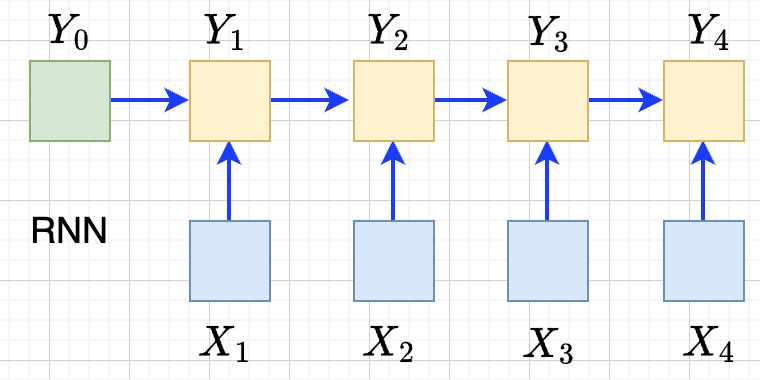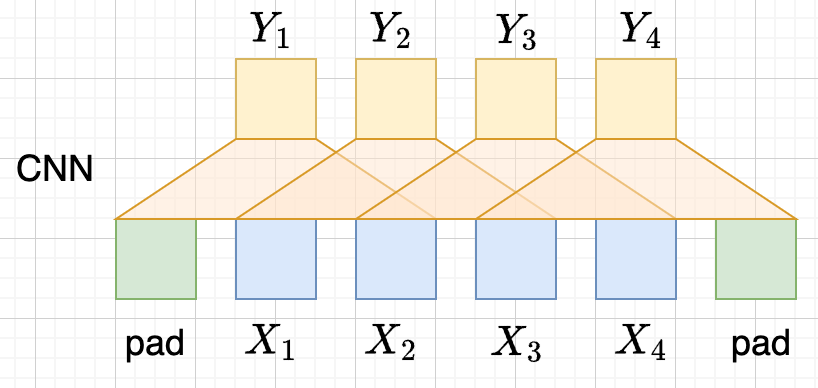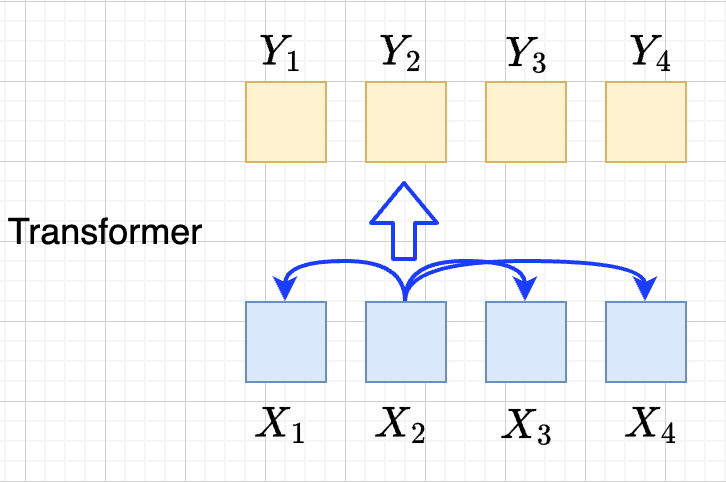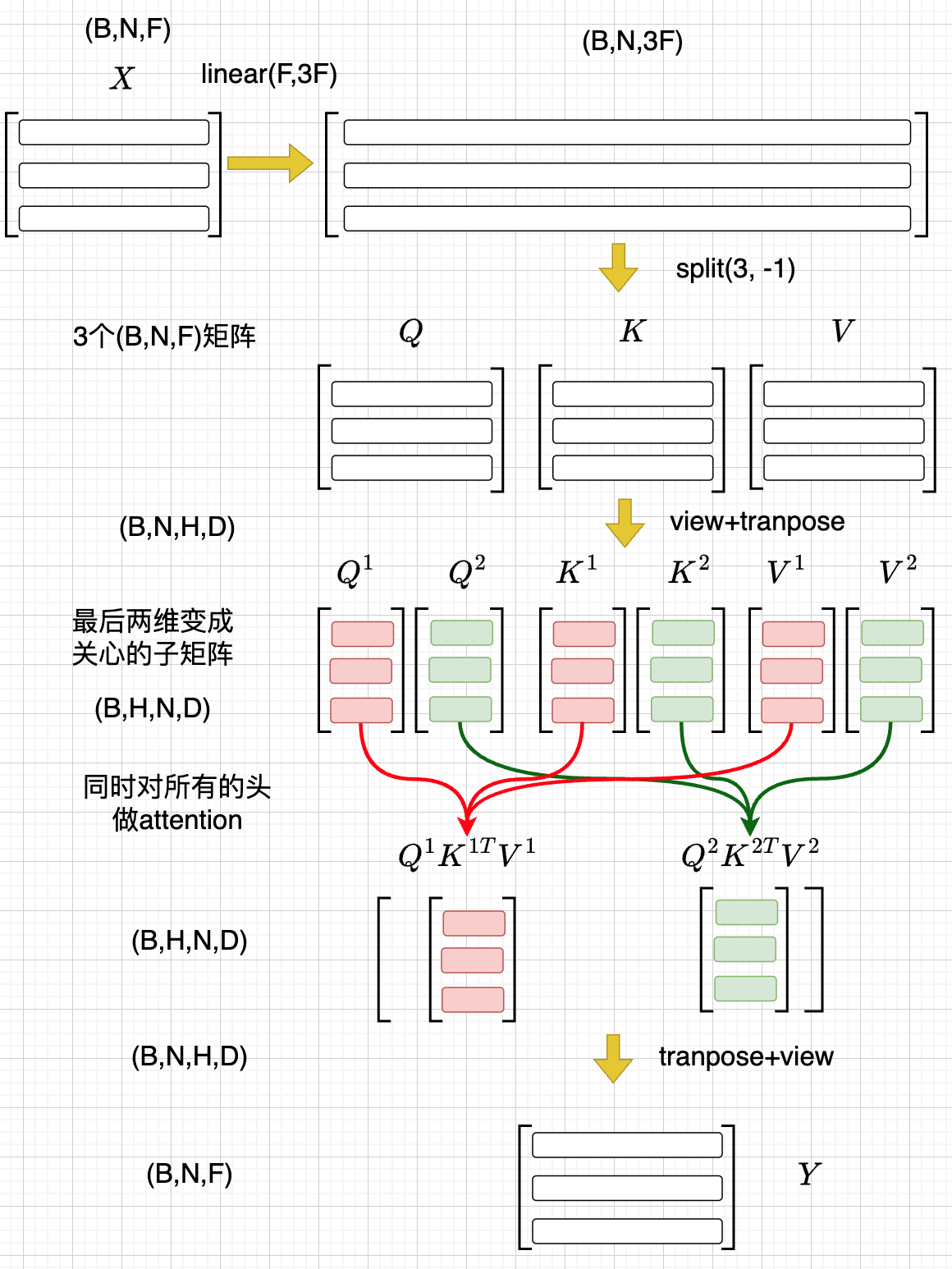深入理解transformer
transformer背景
主要内容
- 主要内容
- attention设计原理解读
- tranformer中的矩阵/行向量乘法
- transformer的pytorch代码实现
- 计算量\(O(N^2)\) 源于softmax的存在
- 从kernel的角度来看attention
- \(\mathcal{A}(X_i) = \dfrac{\sum_{j=1}^{N} sim(Q_i,K_j) V_j}{\sum_{j=1}^N sim(Q_i,K_j)}\)
- linear attention
- 参考
- Attention Is All You Need (Vaswani et al. 2023)
- Fast Autoregressive Transformers with Linear Attention (Katharopoulos et al. 2020)
- mingpt by karpathy
回顾线性代数的知识
why
- 原文比较晦涩 \[\begin{aligned}\mathrm{Attention}(Q,K,V)=\mathrm{softmax}(\dfrac{QK^T}{\sqrt{d_k}})V \\ \mathrm{MultiHead}(Q,K,V)=\mathrm{Concat}(\mathrm{head}_1,\ldots,\mathrm{head}_h)W^{O} \\ \mathrm{head}_i=\mathrm{Attention}(QW_i^Q, KW^{K}_i,VW^V_i) \end{aligned}\]
- 把矩阵剖解成从行向量来看更容易理解
矩阵和行向量
- 矩阵 \(X\in R^{N\times F}\) \(X=\begin{pmatrix} X_{11}, X_{12},\ldots, X_{1F} \\ X_{21}, X_{22},\ldots, X_{2F} \\ \vdots\\ X_{N1}, X_{N2},\ldots, X_{NF} \end{pmatrix}\)
- 行向量 \(X_{i}=\begin{pmatrix} X_{i1}, X_{i2},\ldots, X_{iF}\end{pmatrix}, X_i \in R^{1\times F}\)
- 分块矩阵 \(X=\begin{pmatrix} X_1\\ X_2\\ \vdots\\ X_N \end{pmatrix}\)
- 比如nn.Embedding 按照行向量来组织数据
| |
例子
\(N\) 个token,\(F\) 是embedding的维度
每行对应于一个token的embedding 行向量
\(tokens=\begin{pmatrix} \text{hello} \\ \text{world} \\ \text{pad} \\ \text{pad} \\ \text{pad} \end{pmatrix}\)
\(X=\begin{pmatrix} [0.59, 0.20, 0.04, 0.96] \\ [0.96, 0.30, 0.16, 0.63] \\ [0.02, 0.19, 0.34, 0.25] \\ [0.02, 0.19, 0.34, 0.25] \\ [0.02, 0.19, 0.34, 0.25] \end{pmatrix}\)
矩阵相乘和算子作用
- 定义线性算子 \(\mathcal{A}\)
- 可以作用到行向量 \(\mathcal{A}(X_i) = X_{i} A\)
- 也可以作用到矩阵 \(\mathcal{A}(X) = XA\)
- 右乘矩阵等于对每个行向量逐个施加行变换 \(XA=\begin{pmatrix} X_1\\ X_2\\ \vdots\\ X_N \end{pmatrix}A= \begin{pmatrix} X_1 A\\ X_2 A\\ \vdots\\ X_N A \end{pmatrix}= \begin{pmatrix} \mathcal{A}(X_1) \\ \mathcal{A}(X_2) \\ \vdots\\ \mathcal{A}(X_N) \end{pmatrix}=\mathcal{A}(X)\)
- 代码对应于 nn.Linear
| |
- pytorch/tensorflow中的代码都是按照作用于行向量来组织的
从分块矩阵的乘法来看\(QK^{T}V\)
\(S=QK^T\) 行向量两两计算点积相似性
\(\begin{pmatrix} Q_{1}\\ Q_{2}\\ \vdots\\ Q_N \end{pmatrix} \begin{pmatrix} K_{1}^T, K_2^T,\ldots,K_N^T\\ \end{pmatrix}=(Q_{i}K_j^T)_{ij}=S\)
\(SV\) = 对行向量做加权求和
\(\begin{pmatrix} S_{11},S_{12},\ldots, S_{1N}\\ S_{21},S_{22},\ldots, S_{2N}\\ \vdots\\ S_{N1},S_{N2},\ldots, S_{NN}\\ \end{pmatrix} \begin{pmatrix} V_{1}\\ V_{2}\\ \vdots\\ V_N \end{pmatrix}= \begin{pmatrix} \sum\limits_{j}S_{1j}V_j\\ \sum\limits_{j}S_{2j}V_j\\ \vdots\\ \sum\limits_{j}S_{Nj}V_j \end{pmatrix}\)
基于Q,K计算相似性,然后基于V来加权求和
\(QK^{T}V\) 的每个行向量都是\(V\) 行向量的一个加权求和
注
- 左乘以一个矩阵相当于对每个列向量来施加变化
- 论文:一般会有行/列向量两种表示方式
- 代码:基本都是行向量来作为数据组织的标准
- 本文:
- 向量都按照行向量的形式来组织
- 按照作用于单个行向量的方式来讲解transformer
encoder-decoder
- 大部分的s2s 的任务建模为 encoder-decoder的结构
- 机器翻译,语音识别,文本摘要,问答系统等
- encoder
- 把token序列\((x_{1}, x_2,\ldots, x_N)\) 转化为语义向量序列 \((Y_{1}, Y_2, \ldots, Y_N)\)
- 一般组织为多层的网络的形式
- 第一层:基础语义向量序列 \((x_{1}, x_2,\ldots, x_N)\rightarrow (X_{1}, X_2,\ldots, X_N)\)
- 其它层:从低阶语义向量转化为高阶语义向量序列 \((X_{1}, X_2,\ldots, X_N)\rightarrow (Y_{1}, Y_2,\ldots, Y_N)\)
- decoder 基于\((Y_{1}, Y_2, \ldots, Y_N)\) 自回归式的逐个token解码
focus到 encoder部分来理解transformer
低阶到高阶语义向量的转换
encoder的主要工作是寻找算子\(\mathcal{T}\) 将低阶的语义向量序列变换为高阶的语义向量序列 \(\mathcal{T}\begin{pmatrix} X_1\\ X_2\\ \vdots\\ X_N \end{pmatrix} \rightarrow\begin{pmatrix} Y_1\\ Y_2\\ \vdots\\ Y_N \end{pmatrix}\)
- 输入: \(X\) 低阶语义向量序列,输出: \(Y\) 高阶语义向量序列
- 意义
- \(Y_{i}=f(X_{1}, X_2, \ldots, X_{N})\)
- 对低阶语义向量做加工组合处理和抽象,变换为一个高阶的语义向量序列
- 高阶语义向量考虑了 上下文 的语义向量表达
- motivation
- Firth
a word is characterized by the company it keeps.
例子:
The enigmatic smile on Mona Lisa’s face has intrigued art enthusiasts for centuries, leaving them to speculate about its true meaning.
- 用算子作用来表达 \(Y=\mathcal{T}(X)\)
- \(X \in R^{N\times F}\), \(Y=\mathcal{T}(X): \quad R^{N\times F}\rightarrow R^{N\times F}\)
- 这个算子天然可以复合嵌套,形成多层的网络结构 \(Y=\mathcal{T}_{L}\circ \mathcal{T}_{L-1}\circ \ldots \circ \mathcal{T}_{1}(X)\)
核心的问题
问题
如何设计 \(Y_{i}=f(X_{1}, X_2, \ldots, X_{N})\)
- \(Y_{1}, \ldots, Y_N\) 能否并行得到
- \(Y_{i}\) 能否高效的建立起对周围token的远程依赖
RNN

- 递归语义序列 \(Y_{0}\rightarrow Y_1 \rightarrow \ldots \rightarrow Y_{N}\)
- \(Y_{i}=tanh(X_{i}W + Y_{i-1}U)\)
- 串行
- 单方向的依赖关系 \(Y_{3}\) 直接依赖于\(Y_{2}, X_{3}\), 间接依赖于\(X_1\)
CNN

- \(Y_{i}=(X_{i-1},X_i, X_{i+1}) W\) 假设窗口宽度是3
- 并行
- 长距离依赖?
- 一层卷积只能依赖于当前窗口内,不能对窗口外的形成依赖。
transformer思路
设计\(Y_{i}=f(X_{1}, X_2, \ldots, X_{N})\),使得
- 使得 \(Y_{1},\ldots, Y_N\) 可以做并行计算
- 同时解决长距离依赖的问题

\(Y=\mathcal{F}\circ \mathcal{A}(X)\) 做两次矩阵的变换
\(Y=\mathcal{A}(X)\) MultiHead Attention
- 高阶的语义等于对 全部 的低阶语义向量基于 相似性(Attention) 做 加权平均
- \(\begin{aligned}\mathcal{A}(X_i) &= \frac{\sum_{j=1}^{N} sim(X_i,X_j) X_j}{\sum_{j=1}^N sim(X_i,X_j)} \end{aligned}\)
- attention = 相似性
\(Y’=\mathcal{F}(Y)\) Position-wise Feedforward
- 再施加若干非线性变换
tranformer网络结构
基于KV查询的相似性计算
\[\begin{aligned}\mathcal{A}(X_i) &= \frac{\sum_{j=1}^{N} sim(X_i,X_j) X_j}{\sum_{j=1}^N sim(X_i,X_j)} \end{aligned}\]
直接计算相似性?
参数太少
投影到别的空间来计算相似度 \(X_{i}\rightarrow X_iW\)
\(\begin{aligned} \mathcal{A}(X_i) &= \frac{\sum_{j=1}^{N} sim(X_iW_1,X_jW_{2}) X_jW_3}{\sum_{j=1}^N sim(X_iW_1,X_jW_2)} \end{aligned}\)
如果我们记 \(X_{i}W_{1}=Q_i, X_iW_2=K_i, X_iW_3=V_{i}\),
\(\begin{aligned}\mathcal{A}(X_i) &= \frac{\sum_{j=1}^{N} sim(Q_i,K_j) V_j}{\sum_{j=1}^N sim(Q_i,K_j)} \end{aligned}\)
基于KV查询理解
- 把\(X_i\) 投影出三个向量 \(Q_i,K_i,V_i\)
- QKV
- KV 是大家熟悉的key-value存储 \(K_{j}\rightarrow V_{j}\)
- Q 是查询使用的query向量 \(Q_{i}\)
- QKV的查询方法
query查询多个key,获取多个value
最后把这些value加权平均
\(Q_i\Rightarrow \begin{pmatrix} K_{1}\rightarrow V_{1}\\ K_2\rightarrow V_2\\ \vdots\\ K_N\rightarrow V_N \end{pmatrix} \Rightarrow \begin{pmatrix} sim(Q_i,K_1)V_{1} \\ sim(Q_i,K_2)V_{2} \\ \vdots\\ sim(Q_i,K_N)V_N \end{pmatrix}\Rightarrow\sum_{j=1}^N sim(Q_i,K_j)V_j\)
\(\begin{aligned}\mathcal{A}(X_i) &= \frac{\sum_{j=1}^{N} sim(Q_i,K_j) V_j}{\sum_{j=1}^N sim(Q_i,K_j)} \end{aligned}\)
- 参数: 对应于\(Q,K,V\) 产生了三个投影矩阵 \(W_{Q}, W_K,W_V\)
在一个低维空间做attention
单个头的attention
把\(X_{i}\) 从\(F\) 维空间投影到\(D\) 维空间
\(W_{Q}\in R^{F\times D}, W_K\in R^{F\times D}, W_{V} \in R^{F\times M}\)
\(Q_i = X_iW_{Q}, \quad K_i = X_iW_{K}, \quad V_i = X_iW_{V}\)
\(Q_i\) 和所有的\(K_j\) 做基于点积的相似度计算,
这里简单起见,我们省略掉了scaling \(\frac{1}{\sqrt{D}}\)
\(Q_iK^{T}=Q_i(K^T_1, \ldots, K^T_N)=(Q_iK^T_1, \ldots, Q_iK^T_N)\)
对相似度的分布做softmax
\(S=\mathrm{soft}(Q_iK^T_1, \ldots, Q_iK^T_N)=(s_{i1},\ldots, s_{iN})\)
\(s_{i,j}= \dfrac{exp(Q_iK_j^T)}{\sum_{j=1}^N exp(Q_iK_j^T)}\)
加权平均
\(\mathcal{A}(X_i)=\sum_{j=1}^Ns_jV_j=(s_{i1},\ldots, s_{iN}) \begin{pmatrix} V_1\\ V_2\\ \vdots\\ V_N\end{pmatrix}\)
\(\mathcal{A}(X_i) = \mathrm{soft}(Q_iK^{T})V = \mathrm{soft}(X_iW_QW_K^TX^T)XW_V\)
矩阵表达
\(Y=\mathcal{A}(X) =\begin{pmatrix} \mathcal{A}(X_1)\\ \mathcal{A}(X_2)\\ \vdots\\ \mathcal{A}(X_N) \end{pmatrix} =\begin{pmatrix} \mathrm{soft}(Q_1K^T)V\\ \mathrm{soft}(Q_2K^T)V\\ \vdots \\ \mathrm{soft}(Q_NK^T)V \end{pmatrix}=\mathrm{soft}(QK^T)V\)
简化符号 \(sim(Q,K)V\)
代码实现
| |
注:
- \(D\neq F\) 时,\(\mathcal{A}(X)\) 还不可用
在多个低维空间做attention
why
Multi-head attention allows the model to jointly attend to information from different representation subspaces at different positions.
- 一词多义
- 把\(F\) 维的语义向量投影到 \(H\) 个不同的子空间中去计算相似加权组合
做法
- 每个头投做独立的Attention变换 \(\mathcal{A}^{h}(X)\)
- 假设有\(H\) 个头,每个头作用的低维空间维度是\(D\)
- \(D\times H = F\)
- 对\(H\) 个 \(D\) 行向量拼接
- \(W_O\in R^{F\times F}\)
- \(\mathcal{A}(X) = \mathrm{concat}(\mathcal{A}^1(X), \mathcal{A}^2(X), \ldots, \mathcal{A}^{H}(X) W_O\)
- 或者对前面的符号简化
- 在第\(j\) 个子空间做单头注意力 \(Y^{j}=sim(Q^{j}, K^{j})V^{j}\)
- 合并 \(Y=(Y^{1},\ldots, Y^H)\)
代码实现
| |
代码示意

位置无关的全连接
- 两层的全连接 \(\mathcal{F}(X_i)=(g(X_iW_1)+b_1)W_2+b_2\)
代码
| |
归一化 + 残差网络
\(\mathcal{T}(X)=\mathcal{F}\circ\mathcal{A}(X)\)
Layer Normalization
\(\mathcal{A}’(X)=\mathcal{N}\circ\mathcal{A}(X)\) \(\dfrac{x-\mu}{\sqrt{\sigma}}\gamma + \beta,\mu=\dfrac{1}{d}\sum\limits_{i=1}^{d}x_{i}, \sigma=\sqrt{\dfrac{1}{d}\sum\limits_{i=1}^{d}(x_{i}-\mu)^{2}}\) 可以看成是作用在行向量上的算子
行归一化 or 列归一化
- 在NLP的序列建模里面,Layer Normalization
- 在CV/CTR预估里面, Batch Normalization
Why
- padding的影响 不同batch中<pad>个数不同,沿着token方向做归一化没有意义
- 每个位置做独立的归一化更有意义
输入矩阵例子
\(\begin{pmatrix} \text{hello} \\ \text{world} \\ \text{pad} \\ \text{pad} \\ \text{pad} \end{pmatrix} \rightarrow X= \begin{pmatrix} [0.59, 0.20, 0.04, 0.96] \\ [0.96, 0.30, 0.16, 0.63] \\ [0.02, 0.19, 0.34, 0.25] \\ [0.02, 0.19, 0.34, 0.25] \\ [0.02, 0.19, 0.34, 0.25] \end{pmatrix}\)
其他的可能选择
RMSNorm
\(\dfrac{x}{\text{RMS}(x)}, \quad \text{RMS}(x) = \sqrt{\frac{1}{d} \sum_{i=1}^{d} x_i^2}\)
整体的变换
\(Y=\mathcal{T}(X)\)
- Attention \(Z=\mathcal{N}\circ(X+\mathcal{A}(X))\)
- 位置无关的全连接 \(Y=\mathcal{N}\circ(X+\mathcal{F}(Z))\)
residual network
\(\mathcal{A}’(X)=\mathcal{N}\circ(X+\mathcal{A}(X))\) \(\mathcal{F}’(X)=\mathcal{N}\circ(X+\mathcal{F}(X))\)
多层
一个 \(L\) 层的transformer 模型
\begin{equation*} \begin{split} \mathcal{T}(X) & = \mathcal{T}_L \circ \ldots \mathcal{T}_{2}\circ \mathcal{T}_{1}(X) \end{split} \end{equation*}
代码
| |
transformer参数和计算量
关于参数量
- 一般的模型增加复杂度的方式
- 增加深度,增加宽度
- 增加embedding的维度
- 增加词典的大小
- 各种dnn主要的参数位置
- cnn: \(Y_{i}=(X_{i-1},X_i, X_{i+1}) W\)
- rnn: \(Y_{i}=tanh(X_{i}W + Y_{i-1}U)\)
参数的分布
多头注意力 \(4F^2\)
- 每个头有
- 3个投影矩阵 \(W_Q, W_K, W_V\)
- 1个投影concat结果的矩阵 \(W_O\)
- 参数量: 假设投射到的子空间维度是\(D\), \(H\) 个子空间,\(D\times H = F\)
- \(F\times D \times 3 \times H = 3F^{2}\)
- \(F^{2}\)
FFW \(8F^2\)
- 两个矩阵,先从\(F\) 变宽到\(4F\),再收窄回来到\(F\)
- 参数量\(F\times4F + 4F\times F= 8F^{2}\)
word embedding
\(E\) 是token字典的大小
- \(E\times F\)
total
\(L(12F^{2})+EF\)
| model | 维度 | 层数 | 头数 | 字典大小 | 参数量 |
|---|---|---|---|---|---|
| bertBase | 768 | 12 | 12 | 30000 | 110M |
| bertLarge | 1024 | 24 | 12 | 30000 | 340M |
linear transformer
两个算子的计算量
- \(\mathcal{A}(X)\) 计算量 \(O(N^2)\)
- \(\mathcal{F}(X)\) 计算量 \(O(N)\)
softmax 导致了\(O(N^2)\)
核心的计算量在这三个矩阵的相乘上,\(QK^{T}V\), 乘法的计算量密切依赖于矩阵组合的方式
有softmax的存在的话 只能先计算\(H=QK^{T}\), 对\(H\) 做softmax 变换后,再计算\(HV\) 乘法的计算量是 \(N^2D+N^2M\), 整体的复杂度是\(O(N^{2})\) \(QK^TV=(QK^T)V=\begin{pmatrix} H_{11},H_{12},\ldots,H_{1N} \\ \vdots\\ H_{N1},H_{N2},\ldots,H_{NN} \\ \end{pmatrix}V\)
如果没有softmax的话 可以先计算后两个矩阵相乘\(H=K^TV\), 再计算\(QH\) 乘法的计算量是 \(NDM+DMN=2NDM\),当\(N\gg D\) 的时候, 计算量可以是\(O(N)\), \(K^TV\) 提前算出来缓存,大致如下面这个表达所示 \(Q(K^TV)=\begin{pmatrix} Q_1 \\ Q_2 \\ \vdots\\ Q_{N} \end{pmatrix}(K^TV)\)
kernel
\(\mathcal{A}(X_i)=\dfrac{\sum_{j=1}^{N} sim(Q_i,K_j) V_j}{\sum_{j=1}^N sim(Q_i,K_j)}\)
- kernel: \(k(x,y)=<\phi(x),\phi(y)>\)
\(k(x,y)=(x\cdot z)^2, \phi(x)=(x_{1}^{2},x_{2}^2,\sqrt{2}x_1x_{2})\)
- kernel 对应一个feature map
- 可以用非负的kernel来替换掉
- 当前的sim函数 \(sim(x,y)=\mathrm{exp}(xy^{T}/\sqrt{D})\)
linear transformer \(O(N)\)
- 用kernel来替换掉sim
\[\begin{aligned}\mathcal{A}(X_i) &= \frac{\sum_{j=1}^{N} sim(Q_i,K_j) V_j}{\sum_{j=1}^N sim(Q_i,K_j)} \\
&=\frac{\sum_{j=1}^{N} \phi(Q_i)\phi(K_j)^T V_j}{\sum_{j=1}^N \phi(Q_i)\phi(K_j)^T} \\
&=\frac{ \phi(Q_i) \sum_{j=1}^{N}\phi(K_j)^T V_j}{\phi(Q_i)\sum_{j=1}^N \phi(K_j)^T}
\end{aligned}
\]
- \(\sum_{j=1}^{N}\phi(K_j)^T V, \sum_{j=1}^N \phi(K_j)^T\) 可以提前算好
- \(O(N)\) 复杂度,Linear Transformer
- \(\phi(x)=\mathrm{elu}(x)+1\)
总结
- attention的设计原理解读
- 从低阶语义向量到高阶语义向量的转化 \(\mathcal{T}\begin{pmatrix} X_1\\ X_2\\ \vdots\\ X_N \end{pmatrix} \rightarrow\begin{pmatrix} Y_1\\ Y_2\\ \vdots\\ Y_N \end{pmatrix}\)
- \(\begin{aligned}\mathcal{A}(X_i) &= \frac{\sum_{j=1}^{N} sim(X_i,X_j) X_j}{\sum_{j=1}^N sim(X_i,X_j)} \end{aligned}\)
- \(\mathcal{A}(X_i)=\dfrac{\sum_{j=1}^{N} sim(X_iW_Q,X_jW_{K}) X_jW_{V}}{\sum_{j=1}^N sim(X_iW_Q,X_jW_K)}\)
- \(\begin{aligned}\mathcal{A}(X_i) &= \frac{\sum_{j=1}^{N} sim(Q_i,K_j) V_j}{\sum_{j=1}^N sim(Q_i,K_j)} \end{aligned}\)
- transformer的核心两次变换
- \(Y=\mathcal{F}\circ \mathcal{A}(X)\) 做两次矩阵的变换
- 核心的计算量在这三个矩阵的相乘上,\(QK^{T}V\)
- \((QK^T)V\) 计算量 \(O(N^2)\)
- \(Q(K^TV)\) 计算量 \(O(N)\)
- linear transformer \[\begin{aligned}\mathcal{A}(X_i) &= \frac{\sum_{j=1}^{N} sim(Q_i,K_j) V_j}{\sum_{j=1}^N sim(Q_i,K_j)} \\ &=\frac{\sum_{j=1}^{N} \phi(Q_i)\phi(K_j)^T V_j}{\sum_{j=1}^N \phi(Q_i)\phi(K_j)^T} \\ &=\frac{ \phi(Q_i) \sum_{j=1}^{N}\phi(K_j)^T V_j}{\phi(Q_i)\sum_{j=1}^N \phi(K_j)^T} \end{aligned} \]